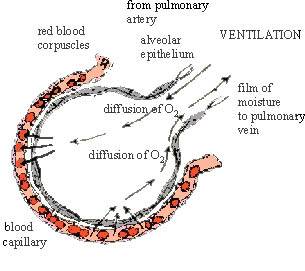|
PinkMonkey Online Study Guide-Biology
In lungs, exchange of gases between inspired air
and the bloodstream takes place through the internal lining of alveoli
due to different concentration gradients and the enzyme carbonic
anhydrase, and air in the lungs soon becomes saturated with carbon
dioxide.
Expiration: Expiration is an automatic or
passive process. During expiration, the intercostal muscles
and the muscles of the diaphragm relax as a result of which the
ribs fall, the sternum sinks and the diaphragm is arched upwards.
This reduces the volume of the cavity of the thorax, and as a result,
air is expelled from the lungs. This outflow of air is called expiration.
During expiration, however, all air is not expelled from the lungs,
but some residual air is always left in the alveoli.

Figure 17.8 Alveolus and terminal bronchiole
Amount of air breathed in and breathed out
(1) Tidal air: It is the amount of air breathed
in and breathed out during restful breathing. It is about 500 ml.
(2) Reserve air: It is the amount of air
which remains in air passages after expiration . It is about 150
ml.
(3) Residual air: It is the amount of air
which remains in the alveoli after forced maximal expiration.
Exchange of gases
The physiology of respiration involves exchange
of gases in lungs and tissues and their transport from lungs to
the tissues and vice versa. Exchange of gases takes place by diffusion
mainly based on concentration gradient.
| 